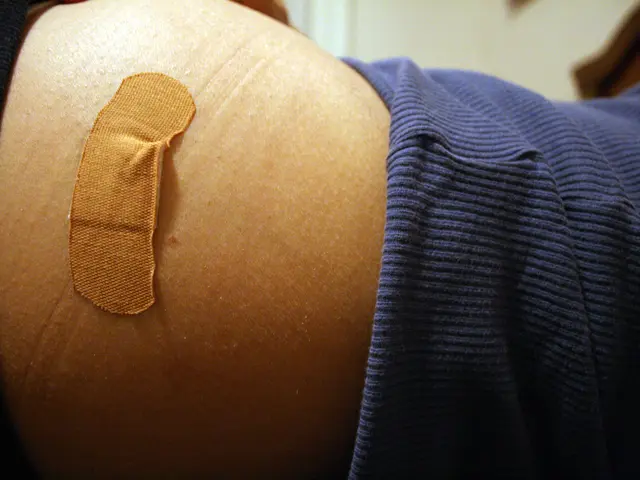Toxic Shock Syndrome: Signs, Origins, Tampon Connection, and Further Details
Toxic Shock Syndrome (TSS) is a rare but serious medical condition that can affect anyone, regardless of age or gender. This article provides an overview of the symptoms, causes, diagnosis, and prevention of TSS.
TSS is primarily caused by bacterial toxins produced mainly by certain strains of Staphylococcus aureus and Streptococcus pyogenes. These bacteria can enter the body through an opening in the skin, such as a cut, sore, or other wound. TSS has been linked to superabsorbent tampon use, but it can also occur with post-surgical infections, burns, cases of nasal packing after nosebleeds, and even dialysis catheters.
The origin of TSS often leads to symptoms such as sudden fever, headache, low blood pressure (hypotension), muscle aches, confusion, diarrhea, nausea, vomiting, rash, redness of eyes, mouth, and throat, seizures, organ failure, sore throat or problem swallowing, and symptoms similar to the flu. Signs of coagulopathy may include irregular heartbeat, chest pain, fast and shallow breathing, anxiety, dilated pupils. Signs of heart failure may include heart palpitations, chest pain, wheezing, coughing, lack of appetite, inability to concentrate, fatigue, weakness, foot and leg swelling, shortness of breath. Signs of kidney failure may include fatigue, weakness, nausea and vomiting, muscle cramps, hiccups, persistent itching, chest pain, shortness of breath, high blood pressure, sleep problems, swelling in the feet and ankles, problems urinating. Signs of liver failure include yellowing of the skin and eyes (jaundice), upper abdominal pain, difficulty concentrating, nausea, vomiting, confusion, dark urine, sleepiness.
If TSS is caused by a vaginal sponge or tampon, it may need to be removed. If TSS is caused by an open or surgical wound, the wound may be drained to clear infection. A blood or urine test is performed to check for bacteria. A CBC (complete blood count) is done to test for white blood cell count or a decrease in platelets. A coagulation study is done to evaluate blood clotting ability. Samples are analyzed for bacteria that cause TSS, and a blood test is conducted to check liver and kidney function. Gamma globulin injections may be given to suppress inflammation and boost the immune system.
Surgical debridement (removal of infected deep tissue) may be performed in severe cases. Medication to stabilize blood pressure may be administered. A diagnosis of TSS is typically made based on a physical examination and symptoms.
Certain precautions can reduce the risk of developing TSS. These include changing tampons, wearing low-absorbency tampons or sanitary napkins, using a reusable silicone menstrual cup and cleaning hands thoroughly when changing it, wearing a sanitary napkin on light-flow days, washing hands frequently, keeping cuts and surgical incisions clean and changing dressings often, not wearing tampons if there is a personal history of TSS.
If you experience the above symptoms after using tampons, after a surgery or skin injury, contact your doctor immediately. It's important to remember that TSS is a rare condition, but understanding its symptoms and risk factors can help ensure timely diagnosis and treatment.
The average number of TSS cases a year in the United States is about per 100,000 people. Infants and the elderly are more at risk for developing a GAS infection and TSLS. TSS can affect males, children, and people of all ages, not just menstruating people.
In conclusion, TSS is a serious condition that requires immediate medical attention. By understanding its symptoms, causes, and prevention methods, individuals can take steps to reduce their risk and seek prompt treatment if needed.
Read also:
- Identifying Sinus Infection Type: Discerning between Viral and Bacterial Sinusitis
- Exploring Colostrum's Storage Duration at Ambient Conditions: A Detailed Handbook
- Bishop expresses that Respect Life Month holds additional significance during the Jubilee Year
- Protesters personally deliver correspondence to Fetterman's workplace








